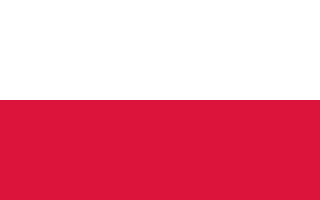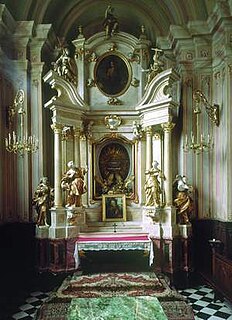| Feliks Zamoyski | |
|---|---|
| Coat of arms | Jelita |
| Born | 15th century |
| Died | 1535 |
| Family | Zamoyski |
| Consort | (?) Smoczek Anna Uhrowiecka |
Issue | |
| Father | Florian Zamoyski |
| Mother | Anna Komorowska |
Feliks Zamoyski (died 1535) was a Polish nobleman (szlachcic).

Poland, officially the Republic of Poland, is a country located in Central Europe. It is divided into 16 administrative subdivisions, covering an area of 312,696 square kilometres (120,733 sq mi), and has a largely temperate seasonal climate. With a population of approximately 38.5 million people, Poland is the sixth most populous member state of the European Union. Poland's capital and largest metropolis is Warsaw. Other major cities include Kraków, Łódź, Wrocław, Poznań, Gdańsk, and Szczecin.
He became the voivode of Bełz Voivodeship in 1514, the Łowczy of Chełmno in 1517, and the Wojski of Chełmno, Tax collector (poborca) of Chełmno and Belz in 1524. He also became the District Writer of Chełmno in 1525 and the Podkomorzy of Chełmno.
Voivode or Vojvoda is an Eastern European title that originally denoted the principal commander of a military force. It derives from the word vojevoda, which in early Slavic meant the bellidux, i.e. the military commander of an area, but it usually had a greater meaning. In Byzantine times it referred to mainly military commanders of Slavic populations, especially in the Balkans, first Bulgaria being established as permanent Slavic state in the region. The title voevodas was first used in the work of the 10th-century Byzantine emperor Constantine VII De Administrando Imperio to identify Hungarian military leaders.

Łowczy was a Polish royal court official from the 13th century with responsibility for organising hunts and guarding royal forests against poachers. Masters of the hunt also served at the courts of magnates.

Chełmno is a town in northern Poland near the Vistula river with 20,000 inhabitants and the historical capital of Chełmno Land. Situated in the Kuyavian-Pomeranian Voivodeship since 1999, Chełmno was previously in Toruń Voivodeship (1975–1998).
In 1517 Feliks and his brother Mikołaj received a payment of debt in the amount of 1,000 florins from Jan Ostrowski, a wealthy landowner from what is now known as Skoków. Zamoyski used a portion of the collection to fund the building of a fortified castle which was used in a 1529 battle to repel an invasion by the Crimean Tatars. His grandson, Jan Zamoyski, founded the city of Zamość upon the small village that blossomed around the family manor in 1580 and became its first ordynat. [1]

The Dutch guilder or fl. was the currency of the Netherlands from the 17th century until 2002, when it was replaced by the euro. Between 1999 and 2002, the guilder was officially a "national subunit" of the euro. However, physical payments could only be made in guilder, as no euro coins or banknotes were available. The Netherlands Antillean guilder is still in use in Curaçao and Sint Maarten, but this currency is distinct from the Dutch guilder. In 2004, the Surinamese guilder was replaced by the Surinamese dollar.
Jan Ostrowski is a Luxembourgian international association footballer who plays as a midfielder.

The Crimean Khanate was a Turkic state of the Ottoman Empire from 1441 to 1783, the longest-lived of the Turkic khanates that succeeded the empire of the Golden Horde of Mongol origin. Established by Hacı I Giray in 1441, the Crimean khans were the patrilineal descendants of Toqa Temür, thirteenth son of Jochi and grandson of Genghis Khan through marriage; Temür married one of Genghis Khan's granddaughters. Though, according to a well-know Russian historian, Doctor of Historical Sciences, professor of the Russian Academy of Sciences Zaitsev Ilya Vladimirovich, the Crimean Khanate was an independent state during all its history. The khanate was located in present-day Russia, Ukraine, Romania and Moldova.











